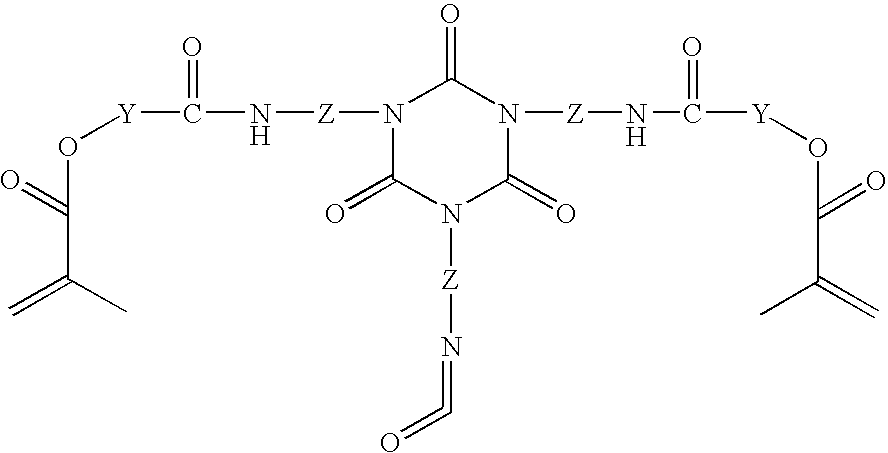Functionalized polymer
a polymer and functional technology, applied in the field of functionalized polymers, can solve the problems of difficult synthesis of a polymer that may be used in a photoresist and that satisfies all the requisites of a photoresist, difficult to form such a copolymer, poor etching resistance of polymers, etc., to achieve the effect of reducing the amount of ethylenically unsaturated monomers, reducing the content of mono
- Summary
- Abstract
- Description
- Claims
- Application Information
AI Technical Summary
Benefits of technology
Problems solved by technology
Method used
Image
Examples
example 1
Copolymer 1 Preparation
[0068] A homogeneous solution containing 250 grams of methacrylic acid, 100 grams of poly(ethoxylate-b-caprolactone) monomethacrylate with 6 ethoxylations and 650 grams of methyl methacrylate was prepared. 75% by weight of the homogeneous solution were transferred into a second flask. The homogeneous solution of the first flask was diluted to 26.0% by weight solids and the homogeneous solution of the second flask was diluted to 60% by weight solids by adding sufficient methyl ethyl ketone.
[0069] The first flask was mixed and heated to reflux under atmospheric conditions. 11 grams of 2,2′-azobis (2-methylbutyronitrile) was added to the reaction mixture, mixed and held at reflux for about 30 minutes.
[0070] 18 grams of 2,2′-azobis (2-methylbutyronitrile) was mixed with 38.0 grams of methyl ethyl ketone and fed into the first flask along with the contents of the second flask over 4 hours while maintaining reflux. An additional amount of 9.0 grams of methyl ethy...
example 2
Copolymer 2 Preparation
[0073] A homogeneous solution containing 250 grams of methacrylic acid, 650 grams of methyl methacrylate and 100 grams of 2-hydroxyethyl methacrylate was prepared. 75% by weight of the homogeneous solution were transferred into a second flask. The homogeneous solution of the first flask was diluted to 25% be weight solids and the homogeneous solution of the second flask was diluted to 60% by weight solids by adding sufficient methyl ethyl ketone.
[0074] The first flask was mixed and heated to reflux under atmospheric conditions. 11 grams of 2,2′-azobis (2-methylbutyronitrile) was added to the reaction mixture, mixed and held at reflux for 30 minutes.
[0075] 18 grams of 2,2′-azobis (2-methylbutyronitirle) was mixed with 40.0 grams of methyl ethyl ketone and fed into the first flask along with the contents of the second flask over 4 hours while maintaining reflux. An additional amount of 10.0 grams of methyl ethyl ketone was then added to the first flask and th...
example 3
Copolymer 3 Preparation
[0078] A homogeneous solution containing 250 grams of methacrylic acid, 650 grams of methyl methacrylate, and 100 grams of poly(ethoxylated) monomethacrylate with 6 ethoxylations was prepared. 75% be weight of the homogeneous solution were transferred into a second flask. The homogeneous solution of the first flask was diluted to 25% by weight solids and the homogeneous solution of the second flask was diluted to 60% be weight solids by adding sufficient methyl ethyl ketone.
[0079] The first flask was mixed and heated to reflux under atmospheric conditions. 11 grams of 2,2′-azobis (2-methylbutyronitirle) was added to the reaction mixture, mixed and held at reflux for 30 minutes.
[0080] 18 grams of 2,2′-azobis (2-methylbutyronitrile) was mixed with 40 grams of methyl ethyl ketone and fed into the first flask along with the contents of the second flask over 4 hours while maintaining reflux. An additional amount of 10.0 grams of methyl ethyl ketone was then adde...
PUM
| Property | Measurement | Unit |
|---|---|---|
| molecular weight | aaaaa | aaaaa |
| temperatures | aaaaa | aaaaa |
| temperatures | aaaaa | aaaaa |
Abstract
Description
Claims
Application Information
 Login to View More
Login to View More - R&D
- Intellectual Property
- Life Sciences
- Materials
- Tech Scout
- Unparalleled Data Quality
- Higher Quality Content
- 60% Fewer Hallucinations
Browse by: Latest US Patents, China's latest patents, Technical Efficacy Thesaurus, Application Domain, Technology Topic, Popular Technical Reports.
© 2025 PatSnap. All rights reserved.Legal|Privacy policy|Modern Slavery Act Transparency Statement|Sitemap|About US| Contact US: help@patsnap.com

